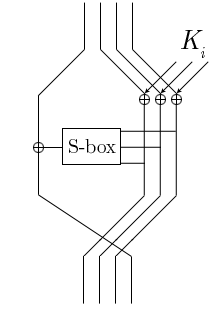| General | |
|---|---|
| Designers | Paul Crowley |
| First published | April 2000 [1] |
| Derived from | WAKE |
| Cipher detail | |
| Key sizes | 128 bits |
| Block sizes | 4096 bits |
| Structure | Feistel network |
| Rounds | 6 |
| Best public cryptanalysis | |
| Scott Fluhrer's differential attack breaks the cipher. [2] | |
In cryptography, Mercy is a tweakable block cipher designed by Paul Crowley for disk encryption.

Cryptography or cryptology is the practice and study of techniques for secure communication in the presence of third parties called adversaries. More generally, cryptography is about constructing and analyzing protocols that prevent third parties or the public from reading private messages; various aspects in information security such as data confidentiality, data integrity, authentication, and non-repudiation are central to modern cryptography. Modern cryptography exists at the intersection of the disciplines of mathematics, computer science, electrical engineering, communication science, and physics. Applications of cryptography include electronic commerce, chip-based payment cards, digital currencies, computer passwords, and military communications.
In cryptography, a block cipher is a deterministic algorithm operating on fixed-length groups of bits, called a block, with an unvarying transformation that is specified by a symmetric key. Block ciphers operate as important elementary components in the design of many cryptographic protocols, and are widely used to implement encryption of bulk data.
Disk encryption is a technology which protects information by converting it into unreadable code that cannot be deciphered easily by unauthorized people. Disk encryption uses disk encryption software or hardware to encrypt every bit of data that goes on a disk or disk volume. It is used to prevent unauthorized access to data storage.
The block size is 4096 bits—unusually large for a block cipher, but a standard disk sector size. Mercy uses a 128-bit secret key, along with a 128-bit non-secret tweak for each block. In disk encryption, the sector number would be used as a tweak. Mercy uses a 6-round Feistel network structure with partial key whitening. The round function uses a key-dependent state machine which borrows some structure from the stream cipher WAKE, with key-dependent S-boxes based on the Nyberg S-boxes also used in AES.
In modern cryptography, symmetric key ciphers are generally divided into stream ciphers and block ciphers. Block ciphers operate on a fixed length string of bits. The length of this bit string is the block size. Both the input (plaintext) and output (ciphertext) are the same length; the output cannot be shorter than the input – this follows logically from the pigeonhole principle and the fact that the cipher must be reversible – and it is undesirable for the output to be longer than the input.

In computer disk storage, a sector is a subdivision of a track on a magnetic disk or optical disc. Each sector stores a fixed amount of user-accessible data, traditionally 512 bytes for hard disk drives (HDDs) and 2048 bytes for CD-ROMs and DVD-ROMs. Newer HDDs use 4096-byte (4 KiB) sectors, which are known as the Advanced Format (AF).
In cryptography, a key is a piece of information that determines the functional output of a cryptographic algorithm. For encryption algorithms, a key specifies the transformation of plaintext into ciphertext, and vice versa for decryption algorithms. Keys also specify transformations in other cryptographic algorithms, such as digital signature schemes and message authentication codes.
Scott Fluhrer has discovered a differential attack that works against the full 6 rounds of Mercy. This attack can even be extended to a seven-round variant. [2]





